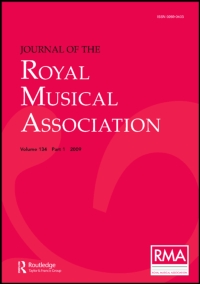Article contents
English Lute Music of the Golden Age
Published online by Cambridge University Press: 01 January 2020
Extract
The music we are going to hear this evening is really the fulfilment of a desire expressed by this Association nearly thirty-one years ago. After a paper on the subject of lute-music by Miss Janet Dodge, Mr. James Matthew said: “We were many of us rather hoping we might have the pleasure of hearing the actual instrument,” and Dr. Southgate added “We should of course have liked to hear the lute.” But in those days much patient effort had still to be made before the art of lute-playing (distinct from a kind of bastard imitation on the guitar) could be said to have been fully recovered; and so they had to be content with a piano. Even to-day, the sound of the lute will be strange and unknown to most of us here; and as I am convinced that any critical discussion of music for an unknown instrument can only be misleading, I have asked Mrs. Poulton to play the very generous programme you have before you, in the hope that you will be able to gain some clear idea how this music really sounded at the hands of its composers.
- Type
- Research Article
- Information
- Copyright
- Copyright © Royal Musical Association, 1938
References
1 “Lute Music of the Sixteenth and Seventeenth Centuries,” by Janet Dodge (Proceedings, xxxiv, 1907–8, p. 123).Google Scholar
2 A Dutch MS., the luitboek van Thysius, also contains five pieces by Dowland, an unacknowledged and almost unrecognisable version of Holborne's Lullabye, and some twenty-five other English pieces.Google Scholar
3 I wonder whether Jane Pickering added the date some years afterwards, or whether the whole thing dates from 1616? If it does, we must conclude that her taste was rather old-fashioned, for all the pieces seem to belong to the end of the last century.Google Scholar
4 Add. 15118, Add. 31432, Harl. 7578.Google Scholar
5 Margaret Glyn, Theory of Musical Evolution, p. 184.Google Scholar
6 Sir W. H. Hadow, English Music, p. 74.Google Scholar
7 As Warlock's version (in The Lute Music of John Dowland) is the only one that will be accessible to many, I give here a list of the mistakes of transcription it contains, together with the two slight mistakes of the original MS.Google Scholar
1. Bar 4: the second (tied) D in the alto should be dotted, and the following C should be a quaver. 2. Bar 6: the second half of the right-hand part should read thus:—Google Scholar

(Warlock's text sounds almost identical, but falsifies the part-writing.) 3. Bar 7: in the tenor, the first G should be sharpened (but the second is natural). 4. Bar 8: in the alto for the crotchet D read the G above, and for the following E♭ read the B♭ below. 5. Bar 25: the final quaver should be G♮. 6. Bar 31: in the last beat of the right-hand part the lower' of the two A's should be dotted, and the higher a semiquaver. 7. Bar 37: in the left hand, for the second quaver read C♮ instead of D, for the third quaver read B (Warlock's E being due to the fact that the copyist wrote fret ‘e’ a string too high—an easy mistake to make), and for the fourth quaver read Bb (the copyist has repeated fret ‘e’ instead of going down to fret ‘d’).Google Scholar
8 “Lute Music of the Sixteenth and Seventeenth Centuries,” by Janet Dodge (Proceedings, xxxiv, 1907–8, p. 123).Google Scholar
- 1
- Cited by


